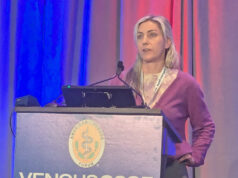
A single-center evaluation of contemporary, multi-modal surgical therapy for venous stasis ulceration (C6 disease) suggests high-risk patients showed similar healing rates at one year, indicating a variety of intervention types should be pursued to achieve “optimal results.”
Presented at the 2023 Southern Association for Vascular Surgery (SAVS) annual meeting (Jan. 18–21) in Rio Grande, Puerto Rico, Rachel Reed, MD, a general surgery resident at Emory University in Atlanta, outlined the “significant burden” chronic venous disease (CVD) has for both patients and the U.S. healthcare system, estimated to affect 3% of the population, with 1–1.5% of the population projected to have healed or active ulcers.
Reed and authors conducted a retrospective review of patients treated with C6 disease at a single, public academic hospital between 2011–2021, with at least 12-months of follow-up. Addressing the field of research, she noted that there are currently “limited data” regarding combined surgical therapy in venous disease, introducing theirs as the “only” study performed to look at multiple types of surgical intervention.
Their primary outcome measure was defined as ulcer-free survival at one year following initial surgical intervention, which included venous ablation, deep venous stenting, and open deep venous valvuloplasty. Patients were classified using the Clinical, Etiological, Anatomical, and Pathophysiological (CEAP) system, which categorizes C6 disease as its most severe form of venous disease, assessed by a multidisciplinary team.
Reed addressed several comorbidities characterizing the “high-risk” cohort, such as diabetes, elevated body mass index (BMI) and active insurance—specifying that 60% of the included population were classified as obese with a BMI of greater than 30, and 35% had a prior history of deep vein thrombosis.
Producing the results, Reed identified the 80 interventional procedures included in their review, segmenting these into 70% ablation, the most frequent treatment used, 21.3% stenting and 10% deep venous reconstruction (DVR). Their findings showed 54% of patients were ulcer-free at 12-month follow-up; however, no significant demographic disparities were found between patients who healed and those who did not. “Of note, those with high-risk features including diabetes and elevated BMI, healed at a similar rate to those without”, Reed asserted.
Overall, 37.7% of patients required more than one type of procedure, 71.7% underwent isolated venous ablation, 13.2% underwent isolated iliac vein stenting, and 1.8% underwent isolated valvuloplasty. Elucidating the data further still, she emphasized a prevalent “trend” that showed patients who required multiple types of intervention to obtain durable venous healing were more likely to have ulcer resistance at 12 months, most likely “highlighting the severity of their disease,” she determined. Yet, despite the number or type of procedure performed, no “statistically significant difference” was observed in level of ulcer healing, Reed stated.
Of note however, when the researchers segmented healing rates of patient limbs by intervention type, concomitant iliac vein disease appeared to be “associated with reduced ulcer healing at one year,” suggesting iliac stenting is associated with poor ulcer healing compared to those individuals who did not require this procedure.
Their research suggests that high-risk features such as diabetes and increased BMI are “not predictive” of poor ulcer healing, with patients from both cohorts healing at “similar” rates, Reed concluded. However, when considered through multivariable regression, Reed saw that significant demographics appeared to be “increased age and lack of insurance” as indicators of reduced healing at 12 months.
Finally, Reed posited the patient population to be the “main” limitation of the study, conveying the difficulties the researchers encountered when attempting to standardize care with the “heterogenous socioeconomic group” of high-risk patients. “Chronic venous disease remains a challenging disease to treat, and in which to obtain durable venous healing,” Reed contended, determining “future studies will need to be performed on optimal treatment pathways for these patients.”











